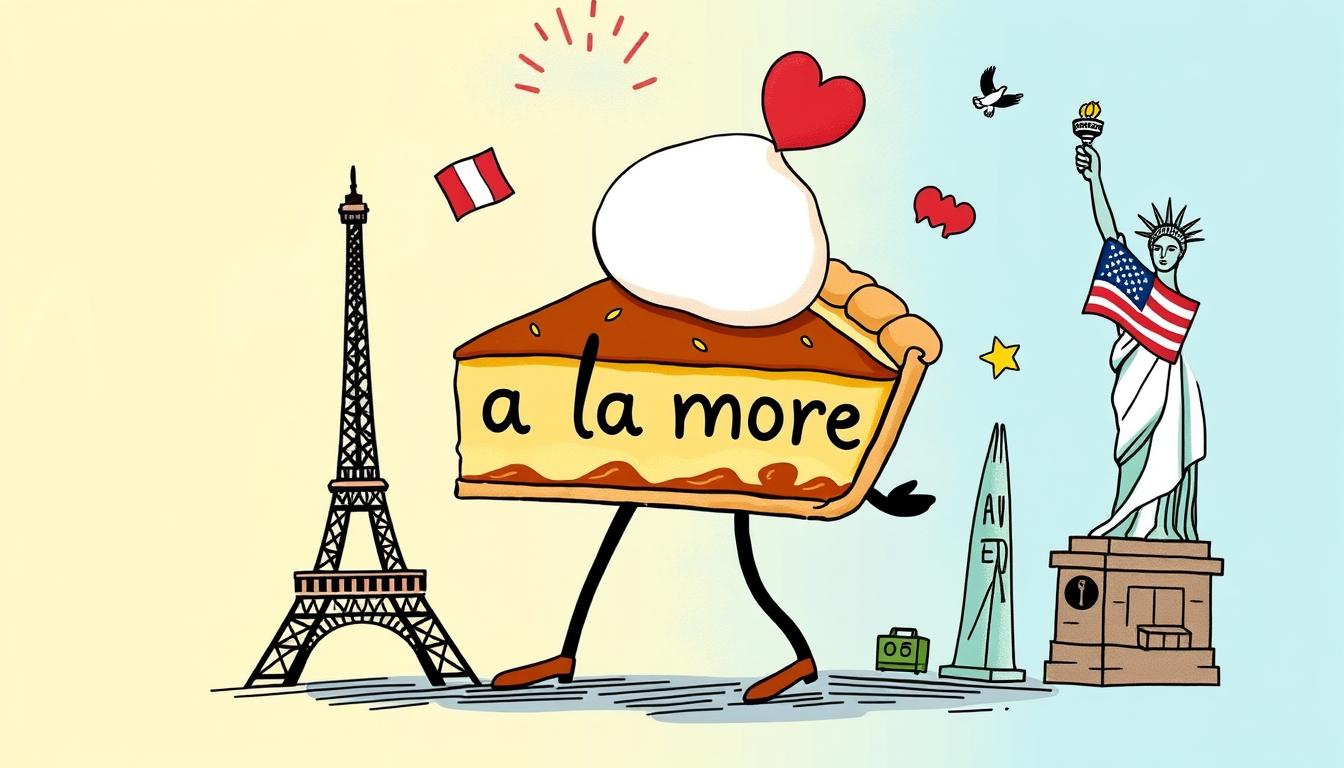Ever wondered about “a la mode”? As a food lover, I’ve always been curious about this term. It’s a big part of American food culture. Why do Americans say “a la mode”?
I remember getting apple pie “a la mode” at our local diner. It was amazing. The flaky crust, tart fruit, and creamy ice cream were perfect together. But what does “a la mode” really mean?
Key Takeaways
- The term “a la mode” came from French and entered English in the 1600s.
- In the early 1900s, it started to mean “served with ice cream” in the U.S.
- In America, “a la mode” usually means desserts with ice cream.
- In the U.S., the ice cream meaning is way more common than the French one.
- Terms like chic and trendy are related to “a la mode”.
The Meaning of “A La Mode”
In the world of food, “a la mode” means something special. It’s a dessert served with a scoop of ice cream. This is common in American restaurants, especially with classic pies like apple pie.
The term is so well-known in American dining that it’s often used without needing to say “with ice cream.” It’s understood to mean just that in a dessert setting.
Definition in Culinary Terms
The way to say “a la mode” in American English is /ˌɑː lə ˈmoʊd/. Here’s how it breaks down phonetically:
- /l/ as in “look”
- /ə/ as in “above”
- /m/ as in “moon”
- /oʊ/ as in “nose”
- /d/ as in “day”
In cooking, “a la mode” means a dessert comes with ice cream. This has become a favorite part of American dining. It adds a special touch to classic desserts.
Common Usage in Restaurants
When you see “a la mode” on a menu in an American restaurant, it means ice cream is coming. This is so common that the phrase is often used without needing to explain it. Everyone knows it means ice cream.
The love for “a la mode” desserts in the U.S. shows how much Americans love ice cream. It turns simple treats into something truly special. This tradition is a big part of American dining.
A Brief History of “A La Mode”
The phrase “a la mode” has a fascinating history. It comes from the French language. In the 19th century, it moved to the culinary world, especially in American restaurants.
French Roots of the Phrase
“À la mode” means “in the fashion” in French. It entered the English language in the 1600s. Back then, it meant something was stylish or in vogue.
Transition to American Culture
French cooking influences reached America, bringing “à la mode” with them. In the 19th century, fancy American restaurants used French terms like “à la Milanaise” or “à la Nesselrode.” This change brought a new à la carte dining style.
But, over time, French terms on menus became less common. Yet, “à la mode” stuck, especially with apple pie à la mode.
“The first recorded instance of ‘à la mode’ used in the context of desserts, specifically with ice cream, was in a Chicago Daily Tribune article in 1895.”
Now, “a la mode” is still part of American food talk. It shows how linguistic borrowing and cultural influences shape our food expressions over time.
The Chocolate-Breakfast Connection
The phrase “a la mode” might not seem to link to adding chocolate to breakfast. Yet, it shows how European cooking styles shaped American breakfasts. This led to the love of chocolate in morning meals across the United States.
Origins in European Cuisine
In Europe, sweet dishes were common at breakfast. The French, for example, loved clafoutis. It’s a dessert-like dish with eggs, cream, and fruit. This mix of breakfast and dessert paved the way for chocolate in American breakfasts.
American Adaptation Over Time
When European cooking came to America, the locals made it their own. They added chocolate to breakfast foods like hot chocolate and pancakes. This mix of old and new shows how “a la mode” evolved in American desserts.
“The American tendency to modify European culinary concepts is reflected in the way ‘a la mode’ has become an integral part of the country’s dessert tradition.”
How “A La Mode” Became Dessert
The phrase “a la mode” changed to mean “with ice cream” thanks to American chefs. A music teacher named Charles Watson Townsend loved apple pie with ice cream at Hotel Cambridge in the 1890s. This mix, called “pie a la mode,” became a hit in the U.S. and is now a favorite dessert.
Introduction to Ice Cream
Ice cream’s history goes back to ancient times. But it wasn’t until the 19th century that it became popular in America. The mix of ice cream with desserts like pie made it a favorite in the country.
Evolution of Dessert Terminology
“A la mode” originally meant beef cooked in wine sauce. But by the mid-20th century, it meant desserts, especially with ice cream.
Now, “a la mode” is all about ice cream and classic desserts. This mix of French and American ideas has made a beloved dessert tradition in America.
| Recipe | Ingredients | Calories | Servings | Prep Time | Bake Time |
|---|---|---|---|---|---|
| Homemade Apple Pie a la Mode | Granulated sugar, cinnamon, sea salt, apples, milk, butter | 346 kcal | 8 | 5 minutes | 55 minutes |
| Pumpkin Apple Cobbler | Pumpkin, apples, spices, pie crust | N/A | N/A | N/A | 260 minutes |
| Molasses-Graham Cracker Pudding | Molasses, graham crackers, milk, eggs | N/A | 6 | N/A | N/A |
| Nutty Apple Streusel | Apples, nuts, butter, sugar, flour | N/A | N/A | N/A | 380 minutes |
| Chocolate Cobbler | Chocolate, flour, sugar, milk, butter | N/A | 8 | N/A | N/A |
| Slow-Cooked Hot Fudge Cake | Chocolate, flour, sugar, milk, butter | N/A | 8 | N/A | N/A |
The story of “ice cream history” and “dessert evolution” shows how “a la mode” became a favorite phrase. It’s now a beloved part of American dessert culture.
Regional Variations Across the U.S.
The phrase “a la mode” is known across the United States. Yet, its use and popularity change by region. Different parts of the country use local words or sayings that mean the same as “a la mode” when talking about food.
Differences in Usage by State
In the Southern states, the way “a la mode” is used is shaped by local American food culture. Coastal areas might use it more, while inland places might say something else. Louisiana, with its mix of accents, shows how French heritage and influences from Germany, Ireland, and Italy shape its language.
The Northeast and Midwest have their own regional dialects. This can make “a la mode” sound different in these areas. As culinary trends change, so might how we use “a la mode” in different places.
Pop Culture Influences and Trends
“A la mode” is everywhere in American pop culture, like in movies, TV, and social media. This has helped make it more common and understood everywhere. Even in places where local words were once used, “a la mode” is now more familiar.
| Region | Typical Usage of “A La Mode” |
|---|---|
| Southern States | More common in coastal areas, mixed usage in inland regions with regional dialects |
| Northeastern States and Midwest | Varied usage, with regional dialects potentially influencing alternative phrases |
| Louisiana | Diverse usage, with Cajun and New Orleans influences |
“Over time, Southern accents have evolved into distinct regional forms, with Scottish, Irish, and English influences found throughout the American South.”
Understanding the Popularity
“A la mode” desserts are loved in America for a good reason. They mix warm pie with cold ice cream. This mix of hot and cold, soft and hard, feels great to our senses.
Why Ice Cream and Pie Make a Perfect Pair
The warmth of pie and the coolness of ice cream are a hit in America. Pie’s sweetness and ice cream’s creaminess make a perfect treat. This combo is a favorite in restaurants and homes, loved for its dessert pairings and comfort food.
Nostalgia and Comfort Food
“A la mode” desserts bring back memories and feel like comfort food in American food preferences. They remind us of family times and happy moments. This emotional tie makes them a favorite in America.
These desserts are simple yet indulgent. They are a key part of American food, loved for years. They stand the test of time as a classic comfort food.
“There’s something about the combination of warm, flaky pie and cool, creamy ice cream that just hits the spot. It’s a comforting, nostalgic treat that’s ingrained in our American food preferences.”
| Key Factors Contributing to the Popularity of “A La Mode” Desserts |
|---|
|
Language Evolution and Culinary Terms
The phrase “a la mode” shows how language changes our food experiences. Culinary linguistics explores food words, showing how new words add depth to menus. They bring sophistication and novelty to our meals.
“A la mode” brings elegance to ice cream with desserts. It shows how language can make familiar foods seem more special.
How Language Shapes Our Dining Experience
Language deeply affects how we see and enjoy food. The words we use for dishes, the phrases tied to cuisines, and foreign terms all shape our dining. They make our meals more than just food.
For instance, “entrée” means different things in different places. This shows how American cuisine is influenced by many cultures.
The Role of Borrowed Words
Culinary language is full of borrowed words, mainly from French and Italian. Terms like “à la minute” and “mise en place” add class to our meals. They make our dining more authentic.
Using these words in American cooking not only grows our vocabulary. It also shows the ongoing cultural exchange in food. As we use these words, we learn to appreciate the variety of flavors and traditions in food.
“Language is the road map of a culture. It tells you where its people come from and where they are going.”
– Rita Mae Brown
| Culinary Term | Definition | Origin |
|---|---|---|
| Entrée | A main course or the first course of a meal | French |
| Mise en place | Having all the necessary ingredients and equipment prepared and organized before cooking | French |
| Chef de partie | A chef responsible for a specific station or area in a kitchen | French |
Using borrowed words in our cooking vocabulary enriches our language. It shows the ongoing cultural exchange in food. As we embrace these words, we grow to appreciate the variety of flavors and traditions in food.
Misunderstandings Around “A La Mode”
The term “a la mode” is often misunderstood, even though it’s common in American dining. People might think it means any dessert or have a more complex meaning than it does. This confusion can happen to those new to American dining customs.
Common Misconceptions
Many believe “a la mode” means any dessert, but it actually means a dessert with ice cream. This can be tricky for non-native English speakers or newcomers to American dining.
Some also think “a la mode” means a fancy or special dish. But, it simply means a dessert with ice cream, without any extra meaning.
Clarifying the Term in Context
To clear up confusion, it’s key to use “a la mode” correctly. When you order, say “a la mode” after your dessert to get it with ice cream. In everyday talk, it just means the dessert has ice cream, without any extra meaning.
Knowing how “a la mode” is used can make your dining better. It helps everyone understand each other better, from servers to diners and food lovers.
The Influence of French Cuisine in America
French cuisine has greatly shaped American cooking and dining. The phrase “a la mode” is just one sign of this influence. French cooking methods, ingredients, and terms have become part of American gastronomic history. This has made American food more diverse and rich.
This culinary fusion has led to unique American takes on French dishes. It’s a blend that has enriched American food culture.
French Influence in Culinary Arts
The French cuisine has done more than just introduce “a la mode.” It has brought classic French sauces and baking to America. French-inspired restaurants are now common, showing the lasting impact of French cooking.
Dishes like crème brûlée, ratatouille, and coq au vin are now favorites in the U.S. They highlight the lasting appeal of French-American cuisine.
Lasting Impacts on American Dining
French cuisine has changed more than just dishes. It has improved the dining experience in America. The focus on presentation and the use of special equipment have raised the bar for dining.
This culinary fusion has also led to gourmet food trends and the rise of celebrity chefs. It has made people appreciate the art of French-American cuisine more.
| Iconic French-Inspired Dishes | Culinary Techniques Adopted |
|---|---|
| Crème brûlée | Sautéing |
| Ratatouille | Baking |
| Coq au vin | Braising |
| Beef bourguignon | Roasting |
| Soufflé | Whipping |
“The beauty of French-American cuisine lies in its ability to transcend borders and create a harmonious blend of culinary traditions.”
The Role of Media in Popularizing “A La Mode”
The phrase “a la mode” is now a big part of American food culture. It’s thanks to food media, pop culture, and famous chefs. Movies, cookbooks, and TV shows have made it common.
Movies and Television References
Many classic American films and TV shows have linked “a la mode” with desserts, especially pie. Think of diner scenes where someone orders pie with ice cream. These moments have made the term well-known.
Celebrity Chefs and Cookbooks
Celebrity chefs and their books have also played a big role. Famous chefs often use “a la mode” in their recipes. This makes people more used to the term.
Food media, pop culture, and famous chefs have made “a la mode” very popular. It’s everywhere, from movies to kitchens, thanks to them.
Beyond Ice Cream: Other Uses of “A La Mode”
The phrase “a la mode” is not just for ice cream anymore. Chefs and food lovers are using it to make new, savory dishes. They’re exploring culinary creativity in exciting ways.
Savory Dishes with the Term
Some chefs are adding a twist to savory dishes by calling them “a la mode.” Imagine a steak with a savory ice cream or crunchy topping. It shows that “a la mode” can be more than just sweet.
Creative Interpretations in Food Trends
- Restaurants are now using “a la mode” for creative menu items. Think of a “mac and cheese a la mode” with unique toppings. It’s a new take on a classic.
- Fusion cuisine is also embracing “a la mode.” It means combining different flavors and cooking styles. This creates dishes that surprise and delight.
By using “a la mode” in new ways, chefs and food lovers are breaking free from old cooking rules. They’re showing us the endless possibilities for culinary creativity and food trends.
Final Thoughts on “A La Mode”
A Celebration of Culinary Language
“A la mode” started in French fashion and now is a big part of American desserts. It shows how language changes and grows. This phrase has taken on a new meaning, becoming a favorite in cooking.
Embracing Cultural Fusion in Food
“A la mode” shows America’s love for different foods and flavors. It’s a sign of the country’s openness to new tastes and words. Enjoying “a la mode” desserts lets us appreciate the mix of cultures and languages in food.
The story of “a la mode” teaches us about language and food’s connection. It celebrates the mix of traditions and the growth of culinary diversity. This helps us understand our past and look forward to a future filled with diverse flavors and languages.



